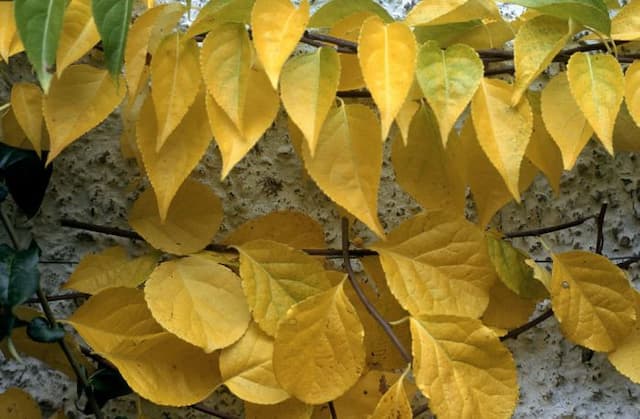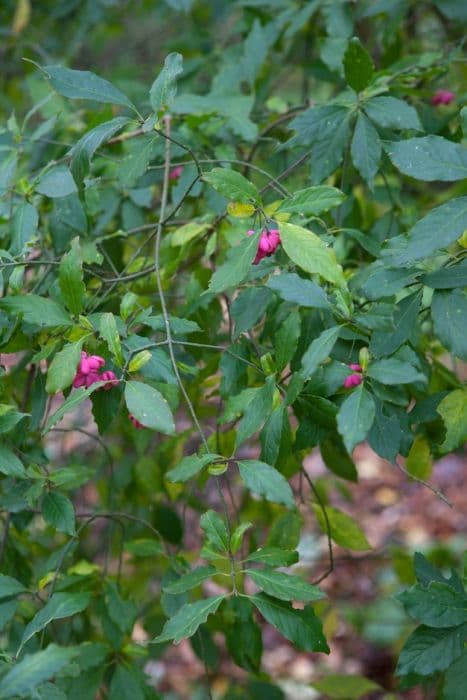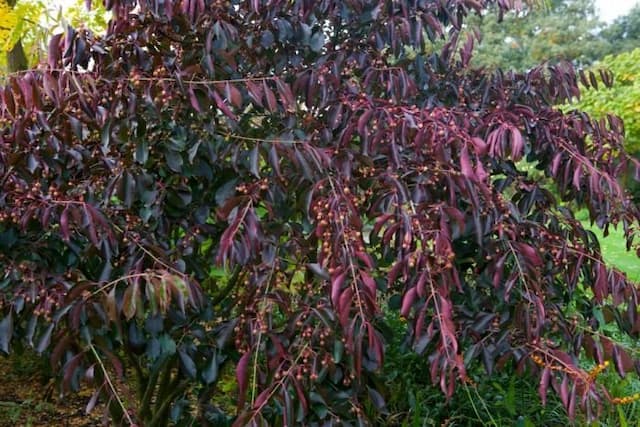Maiten Maytenus boaria

ABOUT
The Maitén is an elegant evergreen tree that is often distinguished by its weeping form, similar to that of a willow. The foliage is dense and comprised of small, delicate, leathery leaves which are narrow and lance-shaped with finely serrated edges. These leaves are a glossy bright green hue that can turn to yellow-green tones under various conditions. The Maitén's bark is smooth and gray, adding to its graceful appearance. During the flowering season, the Maitén produces inconspicuous, yet fragrant little yellowish-green flowers. Because it's dioecious, it bears male and female flowers on separate plants, with the female plants being capable of producing small, round, blackish fruits if a male tree is nearby for pollination. These fruits are attractive to birds and other wildlife, making the Maitén a supportive element in the local ecosystem. Overall, the Maitén has an elegant, weeping silhouette and a lush green presence that can add beauty and shade to the landscape where size is not a constraint.
About this plant
 Names
NamesFamily
Celastraceae
Synonyms
Maiten, Chilean Mayten, Mayten
Common names
Celastrus boaria, Gymnosporia boaria.
 Toxicity
ToxicityTo humans
The plant known as Maiten (Maytenus boaria) is not commonly listed as toxic to humans. However, ingestion of any plant material can potentially cause adverse reactions in some individuals due to sensitivity or allergic reactions, so it is generally advised to avoid eating plants that are not specifically intended for human consumption. Without specific toxicology information for Maiten regarding humans, caution should be exercised.
To pets
The Maiten (Maytenus boaria) is not widely known as a poisonous plant to pets. However, the general principle that pets should not consume ornamental plants applies, as they can have individual sensitivities or allergies, and some plants may cause gastrointestinal upset or other issues if ingested. It's advisable to prevent pets from ingesting this or any other non-food plants to avoid potential health issues.
 Characteristics
CharacteristicsLife cycle
Perennials
Foliage type
Evergreen
Color of leaves
Green
Flower color
Greenish-yellow
Height
15-20 feet (4.57-6.10 meters)
Spread
10-15 feet (3.05-4.57 meters)
Plant type
Tree
Hardiness zones
9
Native area
South America
Benefits
 General Benefits
General Benefits- Ornamental Value: Maytenus boaria, commonly known as Maitén, is often used in landscaping due to its attractive foliage and graceful shape.
- Shade Provider: With its dense canopy, Maitén can provide ample shade in parks, gardens, and public spaces.
- Erosion Control: Maitén's extensive root system can help stabilize soil and control erosion on slopes or embankments.
- Windbreak: Maitén trees can be planted in rows to act as windbreaks, protecting crops or homes from strong winds.
- Carbon Sequestration: Like many trees, Maitén absorbs carbon dioxide from the atmosphere, contributing to the mitigation of climate change.
- Habitat for Wildlife: The Maitén tree offers shelter and food for various bird species and other wildlife, enhancing biodiversity.
- Reforestation: Maitén is sometimes used in reforestation projects because of its adaptability and relatively fast growth.
 Medical Properties
Medical Properties- Anti-inflammatory: Maytenus boaria has been traditionally used to reduce inflammation in various conditions.
- Analgesic: It is said to possess pain-relieving properties.
- Gastroprotective: The plant might have properties that protect against ulcers and promote healing of the digestive tract.
- Hepatoprotective: There may be compounds in Maytenus boaria that help protect the liver.
- Antimicrobial: Some studies suggest that extracts of the plant could have antimicrobial activity against certain pathogens.
 Air-purifying Qualities
Air-purifying QualitiesThis plant is not specifically known for air purifying qualities.
 Other Uses
Other Uses- The wood of Maytenus boaria, commonly known as Maitén, is used in fine carpentry and cabinet work due to its beautiful texture and color.
- Maitén is sometimes used in the construction of musical instruments for its acoustic properties.
- In some cultures, the leaves are used as a natural dye, providing a range of green hues to fabrics.
- The tree is planted as a windbreak in agricultural lands, as it can withstand strong winds and prevent soil erosion.
- Maitén is often used as a shade tree in parks and wide avenues because of its dense and rounded canopy.
- The flowers provide an important source of nectar for bees and other pollinators, supporting local honey production.
- In bonsai art, Maitén can be cultivated and shaped due to its small leaves and attractive growth habit.
- The wood shavings and sawdust of Maitén are used in smoking meats and cheeses to impart a distinctive flavor.
- Its slender and flexible branches are sometimes used for making baskets and other woven craft items.
- The tree’s ornamental appeal makes it a popular choice for ceremonial planting in memory gardens or commemorative landscapes.
Interesting Facts
 Feng Shui
Feng ShuiThe Maiten tree is not used in Feng Shui practice.
 Zodiac Sign Compitability
Zodiac Sign CompitabilityThe Maiten tree is not used in astrology practice.
 Plant Symbolism
Plant Symbolism- Resilience: Maytenus boaria, also known as the Maitén tree, is known for its ability to survive in tough environmental conditions, representing the strength to persist through challenges.
- Growth: The Maitén tree's vigorous growth habits symbolize personal growth and the potential to overcome obstacles.
- Protection: In some cultures, the Maitén tree is used for medicinal purposes, which grants it a symbolism of protection and healing.
- Endurance: The Maitén's hardy nature and longevity make it a symbol of endurance and the ability to withstand the test of time.
 Water
WaterChilean Mayten provides moderate to deep watering. During the growing season, water the plants every week with 1-2 gallons, ensuring moisture reaches the roots. In the dormancy period, reduce the frequency to biweekly, paying attention to rainfall to prevent overwatering. Established trees can tolerate some drought but benefit from consistent moisture, especially in dry climates. Always check the soil moisture before watering; it should be slightly moist at a depth of a couple of inches.
 Light
LightChilean Mayten thrives in full sun to partial shade. It's adaptable but the best spot for planting is an area that receives at least six hours of direct sunlight daily. However, in very hot regions, some afternoon shade is beneficial to prevent leaf scorch.
 Temperature
TemperatureChilean Mayten is hardy in zones 8 to 11, withstanding temperatures as low as 15°F and thriving at a comfortable range between 65°F and 85°F. It can tolerate brief frosts but extended periods of extreme cold or temperatures below the freezing point can damage the plant. The ideal temperature conditions for active growth are between 65°F and 75°F.
 Pruning
PruningPrune Chilean Mayten to maintain shape and promote healthy growth. The best time for pruning is in the late winter or early spring before new growth begins. Remove dead or damaged branches and any that cross or rub against each other. Pruning can be done annually, but since the tree has a naturally graceful shape, minimal pruning is often required.
 Cleaning
CleaningAs needed
 Soil
SoilThe Chilean Mayten tree prefers well-draining soil with a mix of loam, compost, and sand; a pH range of 6.0-7.5 suits it best. Amend the garden soil with organic matter for better results and check drainage.
 Repotting
RepottingThe Chilean Mayten should be repotted every 2-3 years to prevent root-bound conditions and to refresh the soil with a nutrient-rich mix.
 Humidity & Misting
Humidity & MistingThe Chilean Mayten tolerates a wide range of humidity levels; average room humidity is usually sufficient, not requiring high humidity.
 Suitable locations
Suitable locationsIndoor
Ensure bright, indirect light and well-draining soil for indoor Chilean Mayten.
Outdoor
Plant in well-draining soil, full sun to partial shade outdoor for Chilean Mayten.
Hardiness zone
7-10 USDA
 Life cycle
Life cycleMaytenus boaria, commonly known as the Maitén tree, begins its life cycle as a seed, usually dispersed by birds that feed on the tree's fruits. After successful germination, which requires a warm and moist environment, the seedling emerges, prioritizing root development to access water and nutrients. As a young plant, the Maitén tree experiences a phase of rapid vegetative growth, producing leaves and branches that form its characteristic canopy. Upon reaching maturity, which can take several years, the Maitén tree starts flowering, developing small greenish-white flowers that are pollinated by the wind. This pollination results in the production of small, orange-red, edible drupe fruits, which hold the seeds for the next generation. The mature tree can live for many years, providing ecological benefits such as shade and habitat, while continuously going through annual cycles of flowering and fruiting.
 Propogation
PropogationPropogation time
Spring-early summer
The Maiten, or Maytenus boaria, an ornamental tree known for its elegance and tolerance to different growing conditions, is commonly propagated through seeds. The best time to propagate Maiten by seeds is in the late winter or early spring. To do so, collect ripe berries from an existing tree and remove the seeds from the fruit. The seeds need to be washed and can be sown immediately or stored in a cool and dry place until sowing. Once ready to plant, seeds should be sown in a seedbed with well-draining soil at a depth of around 1/4 inch (approximately 6mm). The seeds typically germinate within a few weeks, provided they are kept moist and at a stable temperature around 70°F (approximately 21°C). After germination, seedlings can be transplanted to individual pots and later to their final growing location once they are robust enough to withstand the elements.






